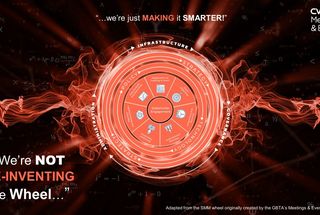Strategic Meetings Management: Why Now Is The Time To Think Outside The Wheel

Albert Einstein said it best: "In the middle of every difficulty lies opportunity." While, to a large extent, business travel and in-person meetings and events remain on hold, many companies are recognizing that this is a great time to establish – or fine-tune – their Strategic Meetings Management programs.
Strategic Meetings Management (SMM), as the name suggests, is a disciplined approach to managing meetings and events across an organization. It can help businesses achieve many objectives, from managing costs to mitigating risk and creating a better experience for meeting organizers and attendees.
You may already be familiar with the SMM Wheel, created by the Global Business Travel Association's (GBTA) Meetings & Events Committee, representing the best-in-class standard for managing an enterprise-wide meetings and events program. While the wheel's 11 components are essential to building an effective SMM program, there is a question that remains: can these components alone help you reach your goals? Over the years, many M&E leaders and practitioners have discovered gaps despite using the wheel as the foundation for their SMM programs. These gaps can include difficulty building a business case with senior leadership, gaining stakeholder buy-in, and ultimately driving adoption for the program across the organization.
With more organizations taking the necessary steps to centralize their meetings and events, I would argue that now is an excellent time for us to start "thinking outside the wheel." The wheel provides an excellent framework, and we don't necessarily want to reinvent it – but we need to find ways to make it smarter, to reach its full potential. We have narrowed this down to three guiding principles:
- Infrastructure – Just as a car needs roads and bridges to get to its destination, it's critical to have an organizational structure that supports the SMM program across your enterprise to help you achieve your goals. This infrastructure encompasses the funding model, resource model, service configuration, technology, and suppliers that you should include as part of your program. These are essential considerations to incorporate before implementing any or all 11 components on the wheel. Feedback from stakeholders will provide insights and answers to several of these questions and help create a strategy around the three guiding principles.
- Governance – If Infrastructure is the roads and bridges, then Governance is the GPS that provides direction. There needs to be oversight of the program to drive change and adoption. It can be done in a mandated or non-mandated environment. The oversight follows the direction of the corporate culture and objectives to align with the business goals. This supports the policy, compliance, resources, processes, and services associated with your SMM program.
- Administration – Continuing with our motoring analogy, this is where the rubber meets the road. Administration is the maintenance required to keep the car up and running. It's the day-to-day operation and support required to execute the SMM program. It drives demand management strategies and ensures a consistent interpretation of policies and processes such as the intake of registered meetings, maintenance of the technology, the service workflow to maintain fair and balanced resources, supplier market share, continuous process improvement, and training. A lead agency model also plays a vital role in extending the SMM program's internal team. This model establishes some centralized services while allowing stakeholders the flexibility and choice of planning services.
Including these guiding principles alongside the SMM wheel's components will establish what is needed to set a clear path forward and help your SMM program quickly gain momentum towards full adoption.
What's more, this approach can (and should) be applied to all meetings across your organization. There is a perception that SMM only includes certain meeting types. Very often, small, virtual, hybrid, executive, and sponsorship meetings, as well as congresses and healthcare professional (HCP) meetings in the life sciences sector, are left out of SMM programs. SMM is evolving to include the totality of all meetings and events activity. At CWT Meetings & Events, we see this evolution as what we refer to as Total Meetings Management (TMM). TMM is the future of SMM. Want to hear more? Look for our next blog, where we will explore TMM in more detail.
New to SMM and want to learn more, have an existing SMM program but don't have the adoption you were hoping for, or maybe you are looking to expand into new markets? We can help! Contact our SMM Consulting Solutions Team for more information.
About CWT
CWT is a Business-to-Business-for-Employees (B2B4E) travel management platform. Companies and governments rely on us to keep their people connected – anywhere, anytime, anyhow – and, across six continents, we provide their employees with innovative technology and an efficient, safe, and secure travel experience.
Engage with us via LinkedIn, Facebook, Twitter and our Podcast.